16 Creative Ways Recipe Developers Use Gochujang
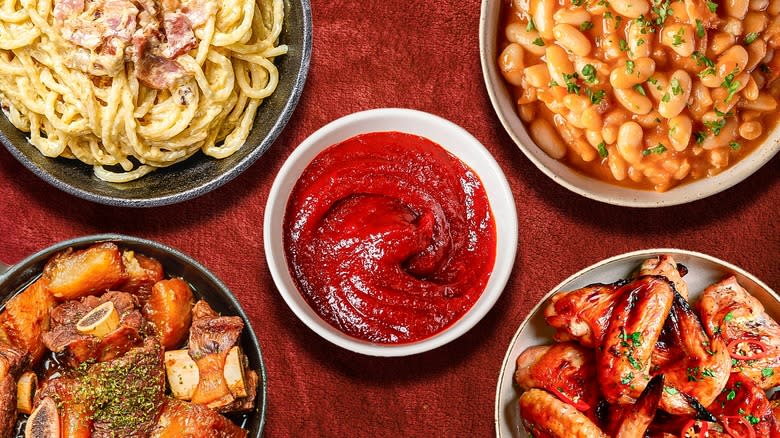
Gochujang is probably one of the most beloved and widely available Korean ingredient staples, and for good reason: Its spicy, sweet, and umami flavor profile can transform even the most basic of dishes into something special, delivering heat and subtle sweetness. The main ingredient in gochujang is gochu chilies, and they're responsible for the red, rusty color of the paste. It also contains sticky rice, which gives the condiment its unique, sticky texture, along with meju, or fermented soybean powder, and barley malt. When all of these ingredients come together, they yield a thick paste that has countless uses in Korean cooking.
Of course, plenty of Korean dishes (like the wildly popular bibimbap, which has now been exported all over the world) call for gochujang. But the versatile ingredient can be used in an incredibly wide variety of recipes, from simple pasta dishes to basic sandwiches to rich, complex desserts. Your best bet? Buy a container of gochujang and try it out, experimenting with written recipes or just riffing with the dishes you make on a regular basis.
Before you start cooking, though, you might want to take a look at these creative ways to use gochujang. We spoke to recipe developers Yu Mon Khin of Khin's Kitchen and Jenny Wooster-McBride of Peel with Zeal to get some interesting ideas. Try some of these ideas out for yourself or let them inspire you to utilize gochujang in a new, unexpected way.
Read more: Vinegar Cooking Hacks You'll Wish You Knew Sooner
Season Your Ribeye Steak With Gochujang
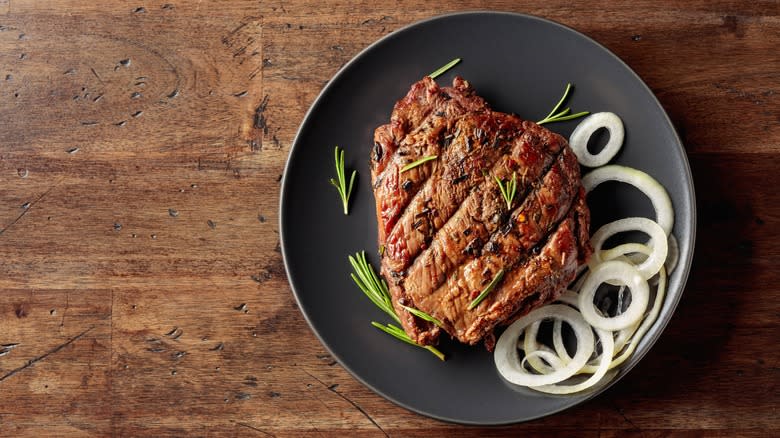
Cooking a ribeye steak — or really any steak, for that matter — to perfection can be difficult, especially if meat isn't your strong point in the cooking realm. But there are some easy ways to add more flavor to your ribeye, and using gochujang is one of them, according to Bobby Flay. First, Flay says, he cooks his ribeye with a spice rub, using high heat to create a lovely crust on the surface of the steak. Then, he slathers it with a gochujang glaze, which brings both spice and sweetness in one package. The result is a wildly flavorful glaze that elevates a basic steak into a dish your family or your guests are unlikely to forget anytime soon.
Because gochujang also boasts an umami profile, it works especially well with meat, including steak. Sometimes, the strong flavors in beef can overpower other, milder flavors, but you won't have that problem with gochujang — because it's fermented and has developed those rich, complex flavors, it can stand up well to the heartiest of meats.
Add It To Your Breakfast Burrito

Starting off your day with a breakfast burrito is a solid way to ensure you're going to stay full and satisfied until lunch, especially if you use plenty of hearty, rich ingredients like eggs, black beans, cheese, and rice. But all of those foods are pretty rich, which can overwhelm your palate if you don't have anything to offset that heaviness. That's exactly where gochujang comes into play. The heat and funky, fermented flavor of the paste works especially well with the richer flavors of the other ingredients typically found in a breakfast burrito, and the sweetness adds an interesting element that balances everything out.
And adding gochujang to your breakfast burrito doesn't have to be a complicated affair. Simply spread some of the paste onto your tortilla (after you've toasted it, of course), then layer on your other ingredients. Wrap it all up, take a bite, and enjoy the magic that is a gochujang-kissed breakfast burrito.
Use Gochujang To Glaze Chicken Wings
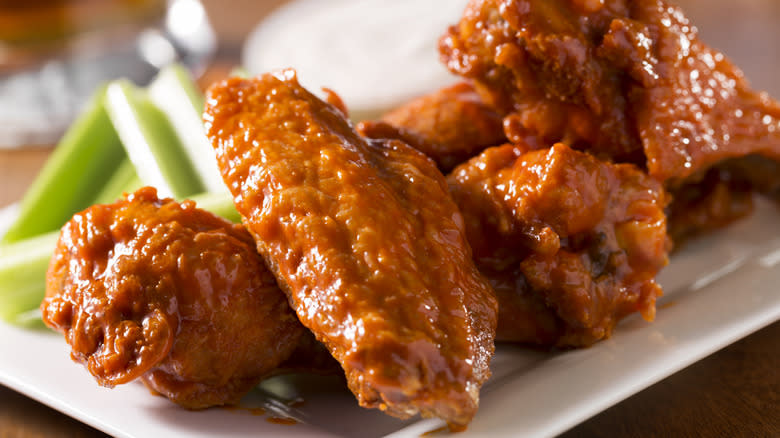
Whether you're preparing food for game day or you're just looking for a savory treat you can snack on with some fresh vegetables, you can't go wrong with chicken wings. Ideally, they're juicy, crispy, and deeply flavorful. But why stick to the same old buffalo sauce you've always used when you could switch things up and try something new? If you're looking for a recipe that yields chicken wings that are spicy, savory, and sweet all at the same time, you should consider using gochujang, says Khin.
"For a unique twist on chicken wings, make a glaze with gochujang, honey, soy sauce, and ginger," she suggests. "Toss the wings in the glaze before baking or air frying. This results in a deliciously sticky, spicy, and savory treat that's perfect for any gathering." The heat from the gochujang is balanced out nicely with the addition of honey, and soy sauce adds a salty, savory element that ties it all together. When you add ginger, your wings will take on a lovely, fragrant quality, as well. We're already drooling.
Make A Chocolate Cake With A Twist
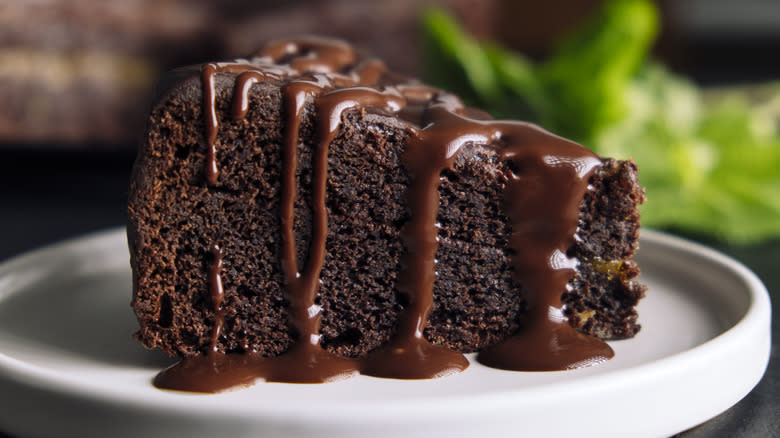
You may assume that gochujang can only be used for savory recipes, but that's far from the truth. In reality, the ingredient can also add an interesting element to a variety of sweet dishes, like gochujang chocolate cake. Yes, you're going to taste a bit of heat in your cake when you use gochujang, but that's kind of the point: A spicy element can balance out an otherwise super-sweet dessert, which gives you a more balanced finished product. And since there's also some saltiness in there, you'll get a chocolate cake that tastes way more complex than your standard recipe.
If you decide to use gochujang in a chocolate cake recipe, you can generally just add 1 or 2 tablespoons in with the other wet ingredients. However, if you don't want the entire cake to feature that gochujang flavor, you can keep things simple and just mix it in with whatever kind of frosting you're using.
Transform A Basic Carbonara Recipe
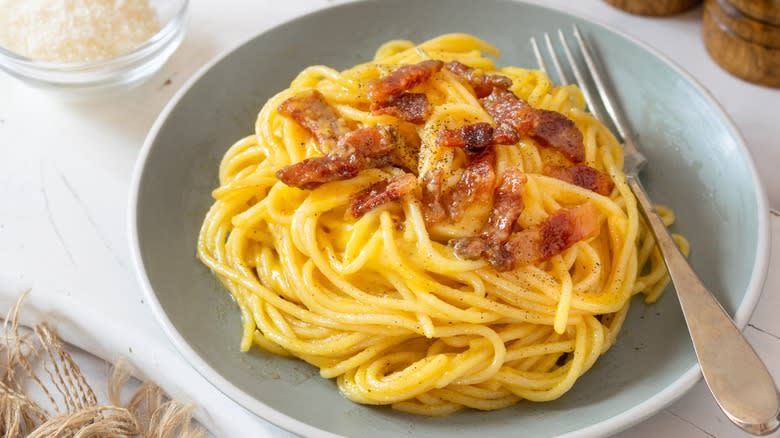
There are some things you just shouldn't add to a carbonara recipe. Peas, for example, are one. Bacon is another. (Guanciale is preferred, although pancetta is also an option.) But there is one less-than-traditional ingredient that definitely can improve a basic carbonara, and that's gochujang. Before you scroll away immediately, hear us out. Gochujang adds some complexity to the rich dish because it adds some tang to the otherwise very rich, egg yolk-based sauce. It also offers a touch of heat and sweetness, which can make a standard carbonara recipe way more interesting.
Cut the paste with some honey and vinegar, and then add it to the pan while you're cooking the pancetta. This will help it blend in with the other ingredients so it coats your pasta easily. Then, just finish off your carbonara recipe like usual, and you'll have an updated pasta dish that's hard not to love. It may not be traditional, but it is delicious.
Add A Gochujang Kick To Your BBQ Sauce
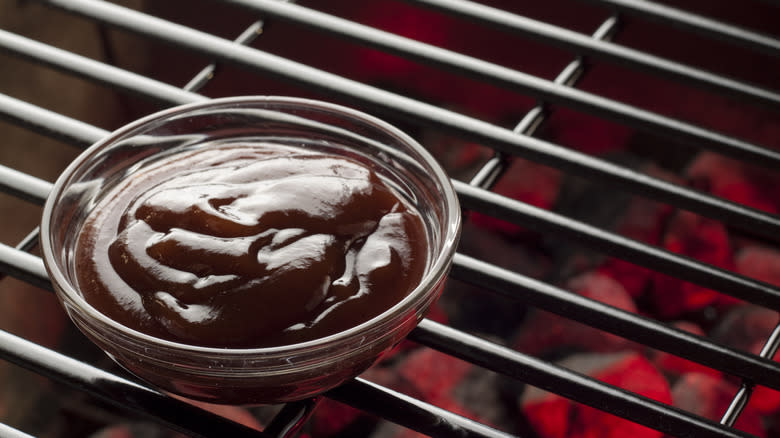
If you've ever tried to make your own BBQ sauce from scratch before (or you've just bought a bad one from the grocery store), you understand the struggle. It's easy to end up with a sauce that's way, way too sweet if you're not careful. But just because you make (or buy) a sauce that's less than delicious doesn't mean you have to throw it down the drain and start all over again. According to Wooster-McBride, gochujang is the perfect ingredient for fixing — or just enhancing — BBQ sauce.
Whether you're tweaking your own homemade batch or a store-bought sauce, she explains, "Start with 1 teaspoon per cup and add more as needed. The spicy umami flavor will neutralize overly sweet sauces." So if you're not a fan of sweeter sauces, then this hack is truly a game changer. But you don't have to stick with an American-style BBQ sauce if that's not what you're craving. Gochujang can come in handy for other types of barbecue, as well. When you want to make a Korean BBQ sauce from scratch, for example, gochujang is a must-include ingredient.
Jazz Up An Egg Sandwich

One easy way to incorporate this ingredient into your cooking is to use gochujang to jazz up a plain egg sandwich. You've got the bread of your choice, along with a fried, scrambled, or sunny side up egg. Maybe you plan on adding mayonnaise, some fresh veggies like arugula or onions, and cheese. So, what's missing? Something with some acidity, spice, and sweetness, of course. That's where the gochujang comes in. Perhaps the easiest way to use gochujang in your egg sandwich is to spread it on the bread, creating a thin layer of spicy, umami flavor. It'll complement those intense, fatty flavors from the other ingredients in the recipe.
However, that's not the only way to use gochujang in your egg sandwich. If you want the flavors to be a bit more integrated in the dish, you can also add gochujang to your eggs while they're cooking. This works especially well with scrambled eggs, but it's also possible to add some gochujang to the cooking oil before you fry an egg in a pan.
Glaze Short Ribs In Gochujang
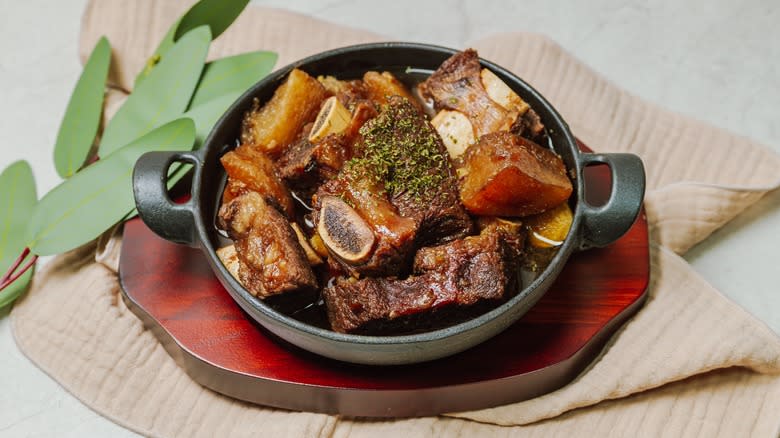
Making short ribs at home can be a lot of work, but it's totally worth it once you taste the finished product. Short ribs are known for being quite tender, particularly when they're braised. But good short ribs aren't all about the texture — it's important to prioritize flavor, as well. That's where gochujang comes in. Gochujang offers an especially complex flavor, and it'll imbue your meat with that same complexity. With spice, sweetness, and tang, gochujang is sure to elevate even the most basic of short rib recipes.
There are two main ways to add gochujang to your short ribs. The first way is to create a glaze, which you'll add to your short ribs after you cook them. However, glazing can take some time, and if you're in a rush to make dinner, it may not be the best option. You can also just add gochujang to the cooking liquid you're braising in, which adds a ton of flavor in one single, easy step.
Add It To Mayo For A Spicy Condiment
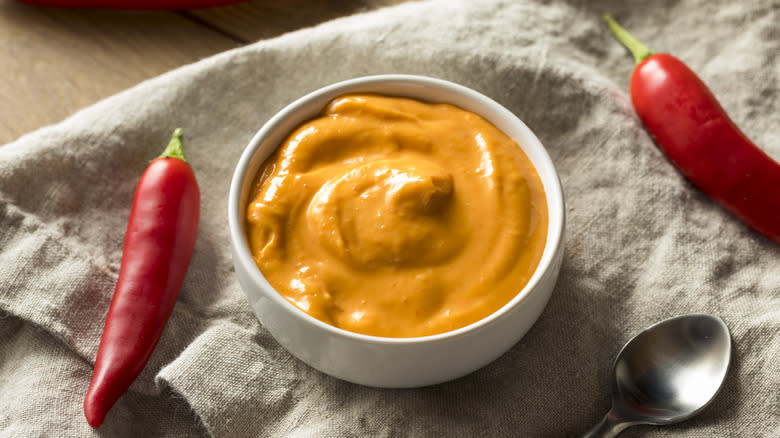
Mayonnaise is delicious on its own, but it's even better when there's some sort of spicy element involved. Often, spicy mayo recipes will call for sriracha or other types of hot sauce, but if you want to add both complexity and spice to your mayonnaise, you may want to use gochujang instead. Khin suggests blending up a few ingredients along with the mayo and gochujang to create a mouthwatering flavor profile.
"Create a spicy mayo by blending gochujang with mayonnaise, lime juice, and a bit of honey," she encourages. Wondering what you're going to do with the mayo once you make it? The possibilities are truly endless. "This versatile condiment is perfect for sandwiches, wraps, and even as a dipping sauce for fries or vegetable sticks," Khin says. Basically, you can use it in anything you'd normally put mayo in. And because it has that extra touch of spice, sweetness, and acidity, it'll balance out other flavors nicely.
Stir Gochujang Into Spicy Caramel Cookies
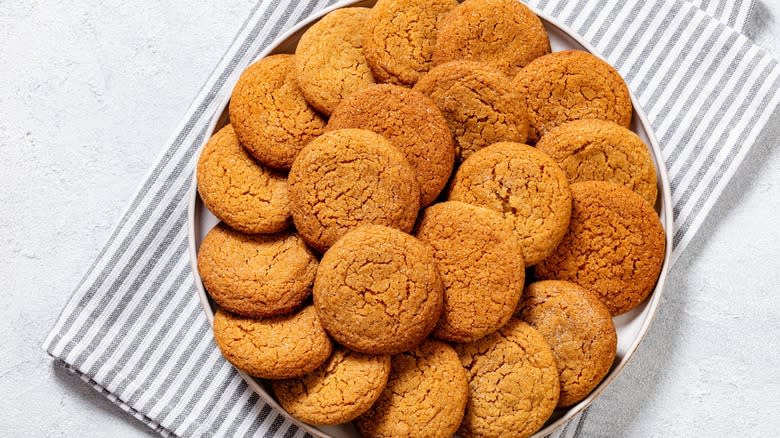
There are some viral recipes that come and go, but others are instant classics — new staples that you'll come back to again and again when you're craving certain flavors. And Eric Kim's gochujang caramel cookies, the recipe for which was published by The New York Times, is one of those instant classics. This combination of flavors might sound nonsensical to the uninitiated, but once you give this recipe a try, you'll wonder why you never thought to add gochujang to your cookies before.
The gochujang in this recipe gives the cookies a touch of spice, but it's not overwhelming — even those who don't generally love spicy foods shouldn't find the spice level too jarring. That's mostly because the recipe calls for plenty of sugar, which sort of blunts that spicy note. When it all comes together, this recipe makes for warming, balanced, and downright delicious cookies you'll want to finish in a single sitting.
Put Gochujang In Soups For A Spicy, Umami Note
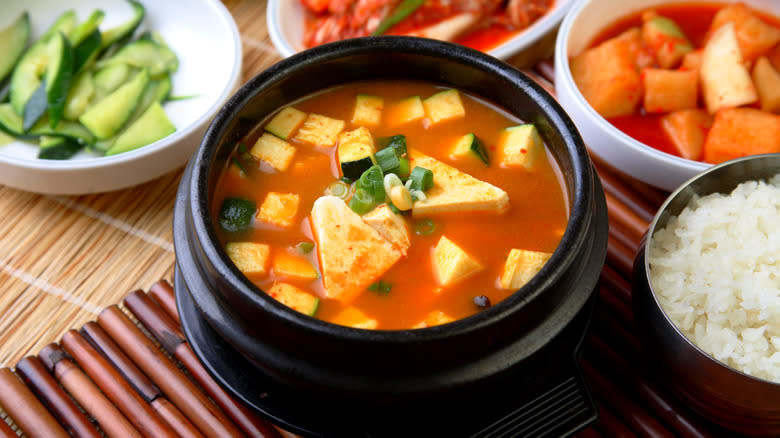
Sometimes, you make a soup from scratch only to realize that it's just ... bland. Unless you're sick and trying to eat especially light, that's probably not exactly what you're going for. That's why you may want to consider adding gochujang to your soup recipes. According to Khin, it can really upgrade your broth, particularly for certain types of soup.
"Add depth to your soups by stirring in a spoonful of gochujang," she suggests. "It works wonderfully in broths for dishes like kimchi jjigae or even a spicy ramen. The gochujang adds a rich, umami flavor that transforms the soup into a comforting and satisfying meal." This is perhaps one of the easiest ways to add more flavor to your soup broth, and it requires basically no extra work. Add a big spoonful for an especially spicy broth, or just use a small amount for a touch of complexity without a lot of extra spice.
Give Plain Buttered Noodles An Upgrade
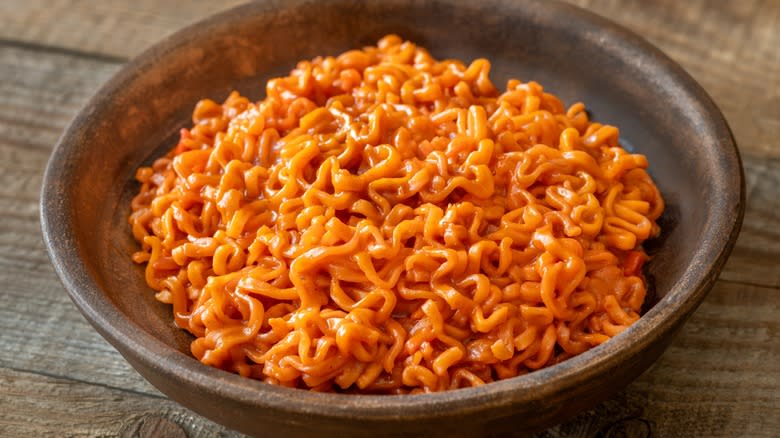
When you're hungry and it feels like you have absolutely nothing in the house to eat, there's one staple meal that almost always hits the spot: buttered noodles. This is one of the simplest dishes you can cook — it's something that even older kids can make on their own. But even after you add a sprinkling of Parmesan cheese, buttered noodles can get old fast. There's just not much going on in terms of flavor. Adding a dollop of gochujang to your noodles, though, can give them a boost of flavor and spice that'll make you feel like you're eating a whole different meal.
One easy way to add gochujang to your pasta is to simply stir the paste into the butter while you're making the sauce for your noodles. But you can also utilize other ingredients along with gochujang to give your pasta even more of a boost. Heavy cream and even peanut butter are also fun additions that can make that spice from the gochujang pop.
Use Gochujang To Make Grilled Cheese With A Punch
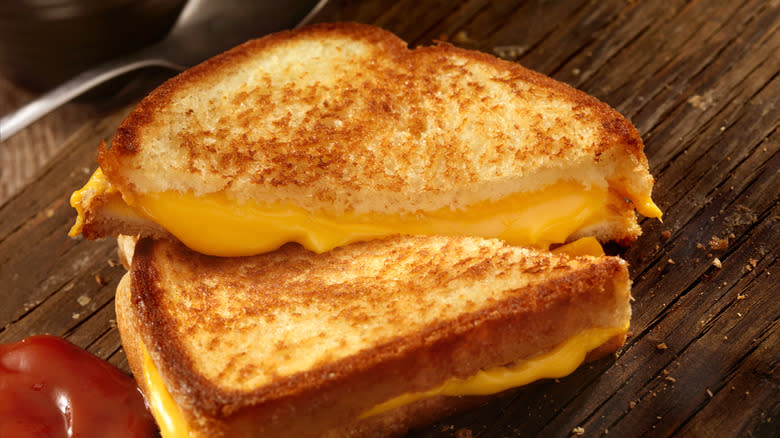
Grilled cheese may be a simple dish, but it's one that most cheese lovers adore. Crispy, buttered bread and creamy, decadent cheese is never not going to be good. But if you're bored of your standard grilled cheese recipe, you may be looking for something to add a bit more flavor to the combo. And if you enjoy spice, sweetness, and savory, umami flavors, then gochujang may be just what you're looking for to make your plain grilled cheese pop.
You can always just spread some gochujang on the bread while you're building your sandwich, but if you prefer more of a diluted flavor, you can also add the gochujang to a different creamy ingredient, like crème fraîche, to cut the spiciness a bit. No matter how you add gochujang to your grilled cheese, though, it may just change the way you make this basic sandwich for the better forever.
Take Your Baked Beans To A Whole New Level
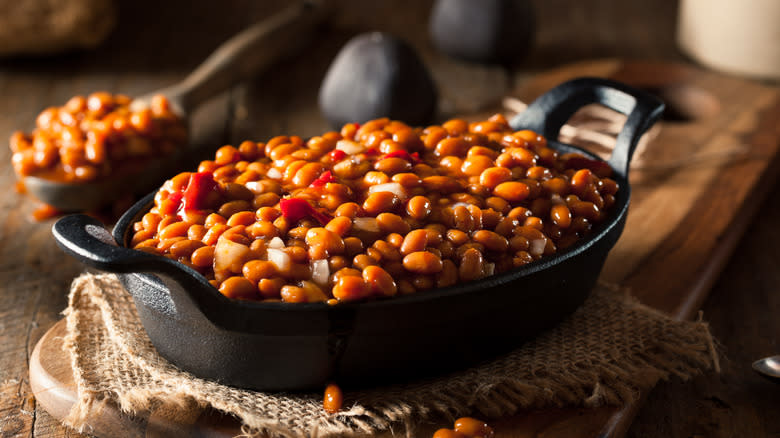
Bean lovers, you're in for a special — and spicy — treat when you add gochujang to your baked beans. Of course, you can add gochujang to canned baked beans. It's an easy way to take a packaged product up a notch in terms of flavor and spice. But perhaps the best way to incorporate gochujang into your baked beans is by making the beans yourself from scratch in a slow cooker. Just add the gochujang to your cooking liquid (and any other spices and seasonings you want), and let the beans cook for several hours until they become soft and tender. Add just a teaspoon of the paste if you want a mild umami flavor, or opt for a larger spoonful if you really want to capture that spice.
There are countless ways to serve your gochujang baked beans. Rice and beans is a classic option, of course, or you could eat these beans as a side for BBQ.
Cook Up Your Own Spicy Korean Bibimbap
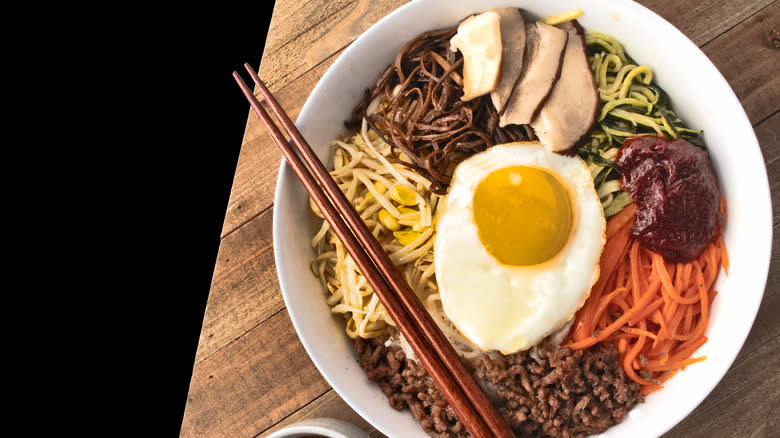
If you love rice, fresh veggies, and of course, gochujang, then bibimbap should be on your weekly recipe rotation. The iconic Korean dish gets its beautiful red hue and signature spicy flavor profile from the inclusion of gochujang. Luckily, if you have some gochujang on hand, you can make bibimbap in your own kitchen, says Khin. Use rice, fresh vegetables like carrots, soybean sprouts, spinach, and whatever else you have in your fridge, and an egg or some sort of protein, then add some flavor in the form of a gochujang sauce.
"Elevate this classic rice dish with a gochujang sauce made by mixing gochujang with sesame oil, garlic, sugar, and a touch of vinegar," she suggests. Using this wide variety of ingredients in your sauce makes for a more balanced, flavorful dish. "Drizzle it over the bibimbap just before serving for a flavorful, spicy-sweet punch that ties all the elements together beautifully."
Make A Gochujang-Based Sauce For Your Fried Chicken Sandwich
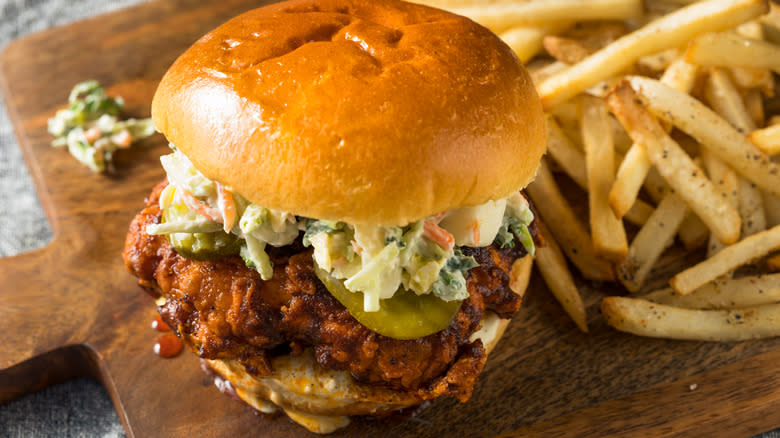
There are few sandwiches in the world as glorious as the fried chicken sandwich, but it's absolutely at its best when it's served spicy. There are countless ways to add spice to a fried chicken sandwich, but gochujang is one of the most flavorful ingredients you could utilize in this context. This chili paste isn't just about heat, and that complexity is what can take an average spicy chicken sandwich recipe and turn it into a dish that's truly memorable.
One easy way to include this spicy condiment in your sandwich recipe is to create a mayo-based sauce — but don't worry if you're not a mayonnaise person. You can also include gochujang in a barbecue sauce or turn it into a glaze for a spicy, sticky sandwich situation. It can even give a teriyaki-style sauce an extra punch of heat and flavor. There are no rules here, so feel free to experiment with gochujang on your fried chicken sandwich as you please.
Read the original article on Tasting Table.


